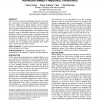Free Online Productivity Tools
i2Speak
i2Symbol
i2OCR
iTex2Img
iWeb2Print
iWeb2Shot
i2Type
iPdf2Split
iPdf2Merge
i2Bopomofo
i2Arabic
i2Style
i2Image
i2PDF
iLatex2Rtf
Sci2ools
IUI
2016
ACM
2016
ACM
SweepSense: Ad Hoc Configuration Sensing Using Reflected Swept-Frequency Ultrasonics
Devices can be made more intelligent if they have the ability to sense their surroundings and physical configuration. However, adding extra, special purpose sensors increases size, price and build complexity. Instead, we use speakers and microphones already present in a wide variety of devices to open new sensing opportunities. Our technique sweeps through a range of inaudible frequencies and measures the intensity of reflected sound to deduce information about the immediate environment, chiefly the materials and geometry of proximate surfaces. We offer several example uses, two of which we implemented as self-contained demos, and conclude with an evaluation that quantifies their performance and demonstrates high accuracy.
| Added | 06 Apr 2016 |
| Updated | 06 Apr 2016 |
| Type | Journal |
| Year | 2016 |
| Where | IUI |
| Authors | Gierad Laput, Xiang 'Anthony' Chen, Chris Harrison |
Comments (0)

